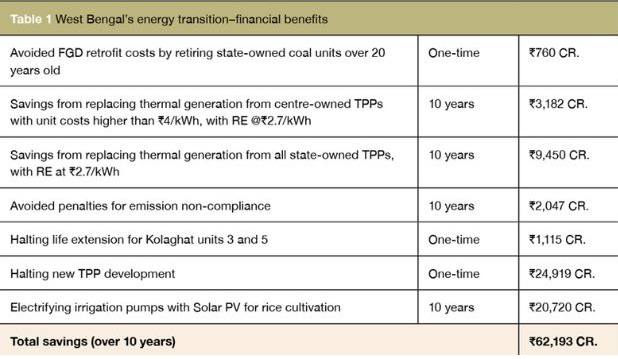 West Bengal Can Save Rs 62,000cr By Roping In Renewables: Report. Photo by-Freepik
West Bengal Can Save Rs 62,000cr By Roping In Renewables: Report. Photo by-Freepik A report by think tank Climate Risk Horizons (CRH) suggests that West Bengal can save thousands of crores in the coming decade by moving away from coal and towards clean energy. The savings accrue through a combination of measures such as the retirement of older, more expensive coal power plants; diverting investment planned for new coal projects to renewables and grid strengthening and the replacement of more expensive coal power contracts with cheaper renewable energy.
Such a planned energy transition would allow West Begal to save approximately ₹62,000 crore over a ten year period compared to a Business As Usual scenario, according to the report.
“With the costs of coal-fired electricity rising, our analysis suggests that West Bengal’s relative neglect of renewable energy so far could be a major missed opportunity. But if this is corrected, it can deliver significant financial benefits for the state’s coffers and electricity consumers,” said Vishnu Teja, author of the report.
About 97% of West Bengal’s power currently comes from coal, with only about 200 MW of wind and solar in the state. Several of the coal power units of West Bengal are also over 20 years old and nearing the end of their life. CRH analysis suggests that phasing out these older, inefficient coal plants will provide immediate savings by way of avoided retrofit costs and lifetime extension costs, and reduced penalties.
Older coal plants are typically less efficient, more polluting and will need to meet the air and water emission norms notified by the Ministry of Environment, Forests and Climate Change or pay penalties. ₹2,250 CR. would be the cost for FGD retrofits on plants that are already over 20 years of age. This amount could be saved if the units in question were retired instead. Similarly, substituting the purchase of higher cost power from centrally-owned coal plants such as Farakka, Kanti Bijlee and DVC with lower cost renewable energy can save up to ₹318 CR. annually. Replacing generation from state owned TPPs that are either older than 20 years or operating at a cost higher than renewable energy can save about ₹945 CR. annually. Electrifying irrigation pumps (for rice cultivation alone) with PV solar can save ₹2,072 CR. annually by way of reduced thermal power demand, according to CRH estimates.
The state government is also considering investing in building new coal capacity, which is estimated to cost about ₹26,000 CR., despite rising coal power costs and the growing attractiveness of renewable energy. Halting the development of these projects and diverting that investment to renewable energy, power storage and grid strengthening would make more financial sense, according to CRH.

“Many of the suggested measures, such as retiring older coal and phasing out expensive contracts, do not require any significant investment. However, building up the state’s renewable energy portfolio will require upfront capital investments in RE, battery storage etc. Options to finance these are similar to other infrastructure investments. The state government can also tap the growing green bond market directly, or in partnership with the private sector. The private sector is keen to invest in RE as long as there are guaranteed offtake and payment security mechanisms. This would probably be the cheapest and most efficient method.”, said Ashish Fernandes, CEO of Climate Risk Horizons.



























